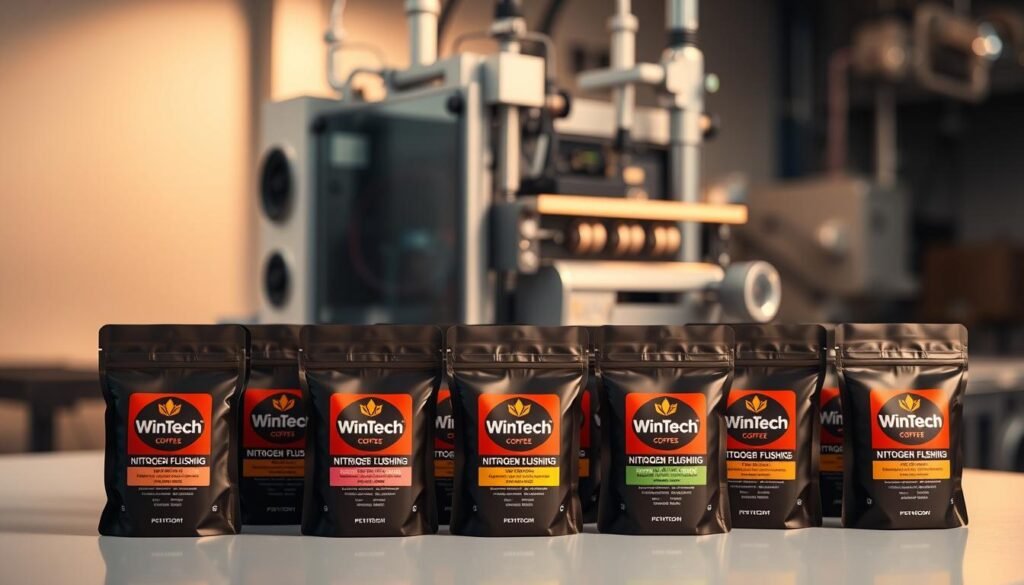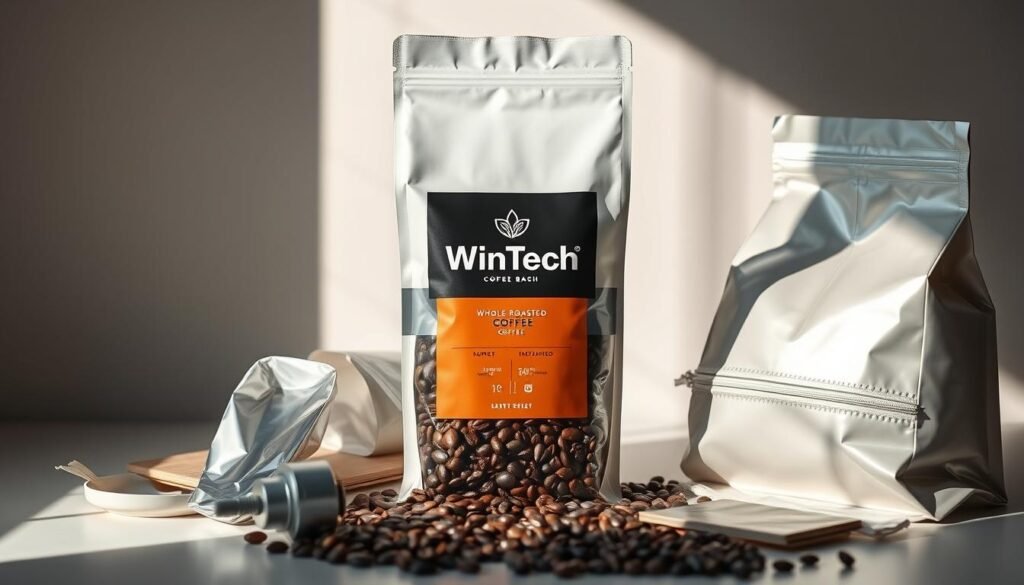Have you ever wondered why your favorite coffee loses its rich flavor so quickly after opening? The secret lies in the Wintech packaging of coffee beans, a critical process that determines the quality and longevity of your morning brew.
Packaging of coffee beans is far more than a simple protective measure. It’s a sophisticated science that preserves the delicate flavors and aromas coffee lovers cherish. Professional coffee distributors understand that oxygen exposure can devastate coffee quality, making nitrogen-flushed coffee packaging an essential preservation method.
When coffee beans are exposed to air, they begin to oxidize rapidly, destroying the complex flavor profiles that make each bean unique. Effective packaging of coffee beans creates a barrier against oxygen, light, and moisture – the three primary enemies of coffee freshness.
Modern coffee preservation methods have revolutionized how roasters protect their premium products. By implementing advanced Packaging of Coffee Beans techniques, they ensure that you experience the same incredible taste from the first cup to the last.
Key Takeaways of Packaging of Coffee Beans
- Proper packaging protects coffee beans from flavor degradation
- Oxygen exposure dramatically reduces coffee quality
- Nitrogen flushing helps maintain bean freshness
- Packaging is a critical step in coffee preservation
- Professional packaging extends coffee’s shelf life
Enhancing Shelf Life Through Effective Packaging of Coffee Beans
Protecting the rich flavors and aromas of coffee requires sophisticated Packaging of Coffee Beans techniques. Coffee enthusiasts understand that the right packaging can transform an ordinary bean into an extraordinary brewing experience.

Proper packaging is crucial for maintaining the quality of whole bean coffee storage. Modern coffee preservation goes far beyond simple bag storage, incorporating advanced technologies that protect your favorite brew.
The Science of Nitrogen Flushing
Nitrogen flushing represents a revolutionary approach in coffee packaging. This process involves:
- Removing oxygen-rich air from coffee bags
- Replacing ambient air with inert nitrogen gas
- Preventing oxidation and flavor degradation
Vacuum sealed coffee bags with specialized degassing valve coffee pouches create an optimal environment for preserving coffee’s delicate characteristics.
Benefits of Sealed Packaging
Sealed packaging offers multiple advantages for coffee preservation:
- Extended shelf life
- Maintained original flavor profile
- Protection from external moisture
- Reduced risk of flavor contamination
Innovative packaging isn’t just about protection—it’s about preserving the essence of your coffee.
By investing in high-quality packaging solutions, coffee producers and consumers can ensure each cup delivers the freshest, most vibrant taste possible.
Key Materials in the Packaging of Coffee Beans
Coffee packaging plays a critical role in preserving the unique flavors and aromas of your favorite brew. The right packaging can make a significant difference in maintaining coffee quality from roaster to consumer.

When selecting packaging for coffee beans, you’ll encounter various materials designed to protect the product’s integrity. Specialty coffee packaging requires careful consideration of several key factors.
Choosing the Right Bags for Optimal Preservation
Airtight coffee packaging is essential for protecting coffee beans from external elements. The most effective bags include:
- Multi-layer kraft paper bags with valve seals
- Aluminum-lined pouches for maximum protection
- Vacuum-sealed containers for extended freshness
Professional roasters prioritize bags that block moisture, oxygen, and light – the three primary enemies of coffee freshness.
Sustainable Packaging Options in Coffee Distribution
The coffee industry is increasingly embracing biodegradable coffee containers to reduce environmental impact. These innovative packaging solutions offer:
- Compostable materials made from plant-based resources
- Reduced carbon footprint
- Appeal to environmentally conscious consumers
Eco-friendly packaging is no longer just a trend – it’s becoming a standard in specialty coffee distribution.
By selecting the right packaging, you can ensure your coffee remains fresh, flavorful, and environmentally responsible from roast to cup.
Best Practices in the Packaging of Coffee Beans
Effective packaging of coffee beans requires strategic approaches that preserve quality and extend shelf life. Distributors must implement robust methods to protect the delicate flavors and aromatic profiles of their coffee products. Proper storage and packaging techniques can make a significant difference in maintaining the coffee’s original taste and freshness.
Coffee preservation methods play a crucial role in ensuring your coffee reaches consumers in peak condition. Professional distributors utilize advanced techniques like nitrogen flushing to remove oxygen from packaging, which dramatically slows down oxidation. Sustainable coffee packaging has become increasingly important, with many brands exploring eco-friendly materials that protect both the product and the environment.
Storing Coffee Bags: Practices for Distributors
Your storage strategy should prioritize temperature control and minimal exposure to light and moisture. Nitrogen-flushed silos can preserve coffee beans for up to a month, providing an optimal environment that prevents quality degradation. Invest in temperature-controlled warehouses and use specialized storage containers that block harmful environmental factors.
Labeling Requirements for Coffee Bean Packaging
Clear and informative labeling is essential for consumer trust and product transparency. Include critical information such as roast date, origin, roast level, and specific storage instructions. Proper labeling not only helps consumers understand the product but also demonstrates your commitment to quality and customer education in the competitive coffee distribution market.
